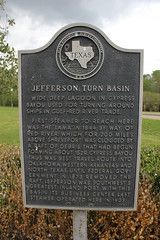Lama
Commemorated on 1 plaque
Texas Historical Marker #08060
Jefferson Turn Basin. Wide, deep lagoon in Cypress Bayou, used for turning around ships in Gulf-Red River trade. First steamer to reach here was the "Lama" in 1844, by way of Red River, which for 200 miles above Shreveport was clogged by a "raft" of debris that had begun forming about 1529. Cypress Bayou thus was best travel route into Oklahoma, western Arkansas and north Texas. Until Federal government in 1873 removed the raft, Jefferson was southwest's greatest inland port, with this basin its business center. Last steamer operated here in 1903. #8060
South Polk St, Jefferson, TX, United States where it was (1843)

